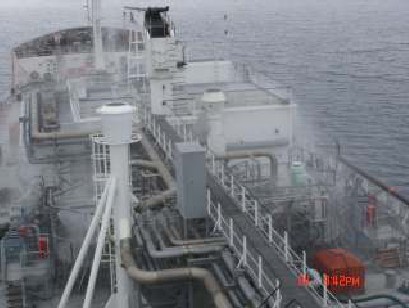
Fig:Semi pressurized LPG carrier underway
Construction
The inner hull volume is used more efficiently than the fully pressurised vessels and the number of tanks varies from 2-6.
A double bottom is constructed for ballast water and the hold space around the cargo tanks does not need to be inerted.
Advantages
The advantages semi-pressurised ships are:
i) More cargo can be carried in a tank of the same capacity
ii) a tank of the same capacity is lighter and cheaper to build
iii) much larger and more economical ships can be constructed.
The first ships to use this new technology appeared in 1961. they carried gases in a semi-pressurized/semi-refrigerated (SP/SR) state but further advances were quickly made and by the late 1960s semi-pressurized/fully refrigerated (SP/FR) gas carriers had become the Ship owner’s choice by providing high flexibility in cargo handling. These carriers, incorporating tanks either cylindrical, spherical or bi-lobe in shape, are able to load or discharge gas cargoes at both refrigerated and pressurized storage facilities.
Related Information:
- Carrying by ethylene carriers
- Carrying bulk liquefied gases by fully refrigerated ships
- Carrying liquefied gases by fully pressurized ships
Transporting liquefied natural gases by LNG ships
Liquefied gas carrier safety training
Benifits of compressed gas technology
Compressed gas liquid carriers (CGLC)
Development and potential of todays emerging gas technologies
Transporting economically viable compressed gas liquids from remote fields Benifits of compressed gas technology
Increased cargo capacity for LNG ships & advantages of the dual fuel diesel electric propulsion
Transporting liquefied natural gases by LNG ships
Gas cargo containment systems - primary barrier (the cargo tank),secondary barrier, thermal insulation and more
External links :
// Home page/// LNG handling /// LPG handling/// Sea transport /// Gas products///
Cargo work ///Fire precautions ///Health hazards ///Safety Precautions
///Emergency response ///
Copyright © Liquefied Gas Carrier.com All rights reserved.
The content published in this website are for general reference only. We have endeavoured to make the information as accurate as possible but cannot take responsibility for any errors. For latest information please visit www.imo.org . Any suggestions, please Contact us !
///Links &Resources // Terms of use/// Privacy policy///Home page///